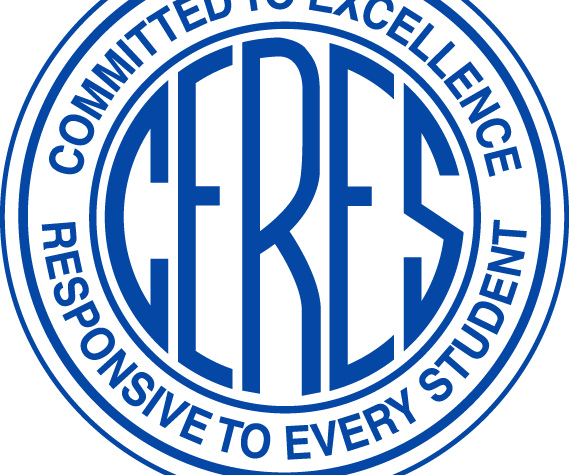Ceres Unified School District continues to make strides to improve service to its students and families, officials explained at the quarterly meeting of the Ceres Community Collaborative.
The group of about 100 educators, Chamber and community leaders heard about the impact that CUSD's afterschool program is having on Ceres youth, how technology is helping youngsters learn and ways help is being extended to needy families. The Common Core Standards were also explained.
Julie Lynn Martin-Borba, the district's grants writer, said about 7,000 of the district's 12,000 students are receiving after school program services. That includes 5,858 in K-8 After School Education & Safety (ASES) programs funded by Prop. 49. The program includes help with academics, homework, character-building activities, sports, daily snacks, holiday celebrations and arts and crafts sessions.
"Ninety percent of our K through sixth graders are attending our after school program," said Martin-Borba. "That's phenomenal considering that the state only pays us for about 15 percent."
A total of 2,549 students are in the Academic Intervention Program (AIP)/ELD program for extra academic help. The program is for students who post CST scores below 350 in language arts or math or those needing to learn English from non-English speaking households.
Of the 1,762 junior high school students in Ceres, 1,001 were in ASES/ASP, which is for tutoring in math and language arts.
"Our district is doing a lot for students after school. We have recreation, we have enrichment, the academics with sports all kinds of things."
The after school programs are having a positive effect on the academic performance of the district. Martin-Borba said the Academic Performance Index (API) is improving with nine elementary schools ranked at 800 or above, which is the state's target. Several schools are right below that mark. Whitmore Charter School of the Arts and Technology has the highest API at 867 points.
"We serve every student who walks through our door. The parents appreciate our program because we do not turn kids away."
To meet the need, CUSD has hired more after school staff and provided more training. In fact the district continues to look for college students to apply for unfilled jobs.
Chris Higle, CUSD's technology director, gave an overview of a three-year development plan being hammered out at present.
"In Ceres Unified, it's very important that it's not about the gadgets or distractions of the latest and greatest thing but it's we're supporting the instructional program," said Higle.
Higle said the state requires districts to develop plans every three years to show how technology is being incorporated in the classroom, including providing internet services.
Students are increasingly using technology for writing, and language arts and solving math problems.
CUSD has a Technology Advisory Committee which will review the plan, which will be submitted to the state in January.
Common core standards explained
The bulk of the collaborative meeting focused on common core standards which the state of California adopted in 2010 with 46 other states.
"This is a significant change in education," explained Debra Bukko, the assistant superintendent in Educational Services. "Education, like any big bureaucracy, does not happen overnight so it's all really starting to come into play in classrooms this year."
California already had some of the most rigorous standards in education in America, she said, so why the change? Bukko said because American lives have changed toward a very digital world and American children are competing with others throughout the world for college and career.
Business owners and colleges are behind the changes. Many employers told educators that students were not coming out of school as critical thinkers. The standards address those concerns.
"They need to be able to have higher thinking critical skills. They need to be able to problem solve. Our standards were good standards before and we had tests that measured those things."
Unfortunately the multiple choice testing method did not challenge thinking.
"The answer is still important and that's one of the misconceptions about common core. People are out there saying they don't have to learn their math facts any more, they don't have to learn multiplication, division out there. That is so not true because students need to have fluency in mathematics. ... the difference is they have to understand where it fits in a larger context and why do we need to know these things."
Common core also has students working together to solve problems rather than individually.
After the 2013-14 school year, students in Ceres will no longer take the STAR (CST) assessments but the Smarter Balanced Assessments instead.
Child welfare
Fabiola Urena, a community liaison with the CUSD Child Welfare Attendance Department explained how services are being given to homeless students or students from families in transition.
A state law called McKinney-Vento Act, calls for services to be extended to "homeless" students whose families are living in motels, trailer parks, campgrounds, or in doubled-up housing. Gas vouchers are supplied for parents who may wish to keep their kids in Ceres schools since moving away. Other services include bus passes to Modesto, back packs and supplies, emergency needs that include clothing, and help with Outdoor Education fees and graduation caps and gowns.





